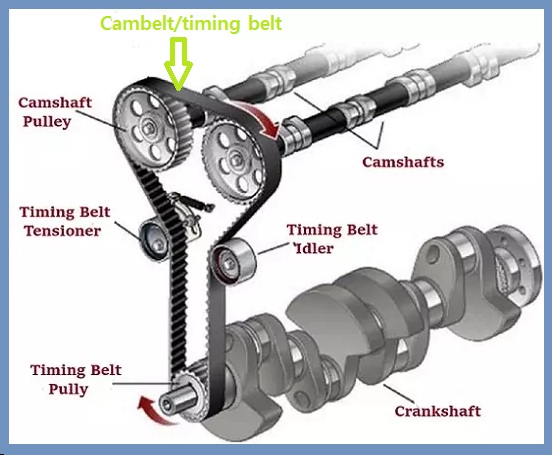Cambelt is also known as a timing belt. Reciprocating engines use cambelts to ensure that the camshaft and crankshaft rotate in proper synchronization. The timing belt or cam belt properly opens and closes the engine valve at the correct timing according to the reciprocating motion of the piston. If the timing belt fails, the engine will not be able to generate power and will not be able to propel the vehicle. Rubber is most commonly used in the construction of timing belts. Synthetic compounds are also mixed with rubber to improve durability. There are teeth (grooves) on one side of the belt to improve grip on the various shaft ends of the engine. If the belt does not have these grooves, it can slip at any time.

This type of belt is attached in a specific pattern along one side of the engine. The main function of the cable is to synchronize the lower half of the engine (crankcase and piston) with the upper half (cylinder head and valve). With the passage of hours, the belt will stretch. Therefore, it will fail without warning. When the engine is idling, you may hear a rattling noise in the area of the toothed belt. This indicates wear on the tensioner or idler pulley and can lead to belt damage. This is a factor that can lead to premature belt failure.
Table of Contents
Design of Cambelt
Most timing belts are made of rubber, but some types of timing belts are also made of neoprene or polyurethane. The tooth surface of the belt is reinforced with a cloth cover and the structure of the belt is reinforced with a fiber cord.

As you know, rubber deteriorates due to extreme temperatures and oil leaks. As a result, the life of the belt will be shortened due to engine overheating or engine oil leakage. In addition, leaks of coolant and water will shorten the life of the reinforced cord. Therefore, it is important that the belt, which can be damaged by water, can be quickly removed the water.
Traditional belts have trapezoidal teeth, which increases the rate of tooth wear. Modern belts have curved teeth with smooth running and long service life.
Manufacturers’ belts can stretch at high speeds, delaying cams and delaying the burning process. The strongest aftermarket belts do not stretch and remain the same over time. Wider straps increase strength and narrower straps reduce friction and weight.
Function of Cambelt
The main function of timing belts is to control the timing of internal combustion engines. Handles the timing and order of opening and closing engine cylinder valves. Also, make sure that the camshaft and crankshaft rotations are properly synchronized.
- Adjust the proper opening and closing of the cylinder valve so that the engine burns fuel properly.
- The crankshaft moves the piston up and down at the same time.
- Tight valve timing can damage pistons, valves, and other engine components.
How to Change Cambelt
The process of replacing the timing belt is very simple. To replace the timing belt, follow the steps below.
- The car has two belts (power steering belt and fan belt) that house the water pump and timing belt. Therefore, to remove a timing belt or timing belt, you must first remove these belts.
- Next, remove the timing case and crank pulley that cover the belt.
- It is best to squeeze the gear before removing the crankshaft pulley. In this way, the parts can be easily reassembled. After performing all these steps, you can easily remove the timing belt.
- Then remove the water pump. Before doing this, make sure there is a bucket under the car to catch the coolant.
- Reassemble the engine with a new timing belt and water pump. Then fill the cooling system with fresh, high-quality coolant.
Applications:
- Improves engine performance.
- Ensures that the cylinder valve opens and closes properly.
- The toothed belt connects the crankshaft and camshaft.
